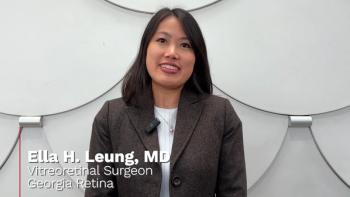
- Ophthalmology Times: November 15, 2020
- Volume 45
- Issue 19
AMA steps up support for gender equity in medicine
The American Medical Association is encouraging women to become involved in policy making and educating health care leaders about the barriers women face in their career development.
Gender equity has been moved to the front burner.
“In recent years, the American Medical Association (AMA) has been very proactive in creating more gender inclusivity in a historically male-dominated field,” according to Susan R. Bailey, MD, president of the AMA.
The first step toward this goal was the creation of the Women’s Physician Section (WPS), which is open to both female and male physicians.
Related:
The section’s goals include increasing the number of women in the AMA House of Delegates, on the AMA board, and in the membership at large; establishing women-led communities to share ideas, advice, and common concerns; and providing support for managing work/life balance, Bailey said.
In addition, the AMA encourages women to become involved in policy making and educating health care leaders about the barriers women face in their career development.
Impact of the WPS
The WPS is focused specifically on matters that have affected women for generations. The AMA adopted a new policy, Principles for Advancing Gender Equity in Medicine, at its 2019 annual meeting.
The policy addresses persistent pay inequities between men and women, promotes gender diversity, ends gender-based discrimination, and encourages expanding parental leave.
The last of these ultimately will provide a huge benefit for new parents. The United States ranks last in the developed world for providing paid family leave for new parents.
Bailey recounted studies that showed that countries such as Bulgaria, Estonia, Hungary, and Japan provide more than 6 weeks of paid leave for new parents through the national governments.
Related:
In contrast, the US offers no such benefit. In the private sector, most civilian companies provide unpaid parental leave, but very few provide any financial support, she noted.
“This is not acceptable, especially in our changing field, in which women now comprise more than 50% of medical students in the US and 40% of residents plan on having a child during training,” Bailey said. “To accommodate this demographic shift, long-standing policies about maternity leave and parental leave need to change.”
To get the ball rolling, the AMA adopted a resolution to study the effects of the Family and Medical Leave Act on physicians in various practice environments.
“The resolution encourages employers to offer and/or expand paid parental leave policies, encourages state medical associations to work with state legislatures to establish paid parental leave policies, advocates for improved social and economic support for paid family leave, and federal tax incentives to support early childhood care,” Bailey said.
In addition to parental leave, there is another area that often is overlooked. As Bailey pointed out, while many women have children during their medical training, even if the program in which they are involved did offer parental leave, if the women take too much time off they become ineligible to sit for their boards.
Related:
For example, the American Board of Ophthalmology offers the written examination once a year in September, which, she noted, does not allow for a great deal of make-up time even if the board allows it.
Bailey provided some good news, noting that the American Board of Medical Specialties passed a rule that will go into effect in summer 2021.
“This states that member boards must allow for a minimum of 6 weeks of time away from training for purposes of prenatal, caregiver, and medical leave at least once during training, without exhausting all other allowed time away from training and without extending training,” she said.
In addition, member boards must allow all new parents, including birthing and non-birthing parents, adoptive/foster parents, and surrogates to take parental leave.
“This is a huge step in the right direction,” Bailey said.
Other issues
Medicine, as in other professions, also has a large pay gap. Bailey noted that women in medicine are paid 20% to 30% less than men.
Another issue is that women do not progress in academia at the same rate as men. Only 25% of women reach the status of full professorship, only 18% are department chairs, and only 16% are deans.
The
“Time will tell how the future career paths will be affected,” she said, suggesting that 1 of the worst effects of the pandemic may be that women are forced back years or decades by being forced to remain home during the pandemic to be caretakers and out of the workplace.
“I predict that our struggle for gender equity will intensify for the foreseeable future,” Bailey concluded. “We are at a crossroads for change. Not only are more women entering medicine, but our country is continuing to have important and difficult conversations about how women are treated in society. The problems will not be solved overnight, but I believe that we can bridge these divides piece by piece by bringing our concerns to the table.”
Susan R. Bailey, MD
e:[email protected]
Bailey has no financial interest in this subject matter.
Articles in this issue
almost 5 years ago
Evaluating scleral biomechanics to pinpoint root of accommodationabout 5 years ago
FA implant outperforms anti-VEGF in DR patients lost to follow-upabout 5 years ago
Challenges to topical drop adherence after cataract surgeryabout 5 years ago
Gene therapy surgical pearls for successful outcomesabout 5 years ago
Eliminating preop fasting leads to happier cataract patientsabout 5 years ago
Pearls for drawing patients back to your practiceabout 5 years ago
Haptic flanging reduces IOL dislocations after cataract surgeryabout 5 years ago
Ophthalmic practices eye private equity investorsabout 5 years ago
Oh, the people we meetabout 5 years ago
Neuro-ophthalmology, NFL connect for a touchdownNewsletter
Don’t miss out—get Ophthalmology Times updates on the latest clinical advancements and expert interviews, straight to your inbox.













































